Chinese Baijiu- All You Need to Know
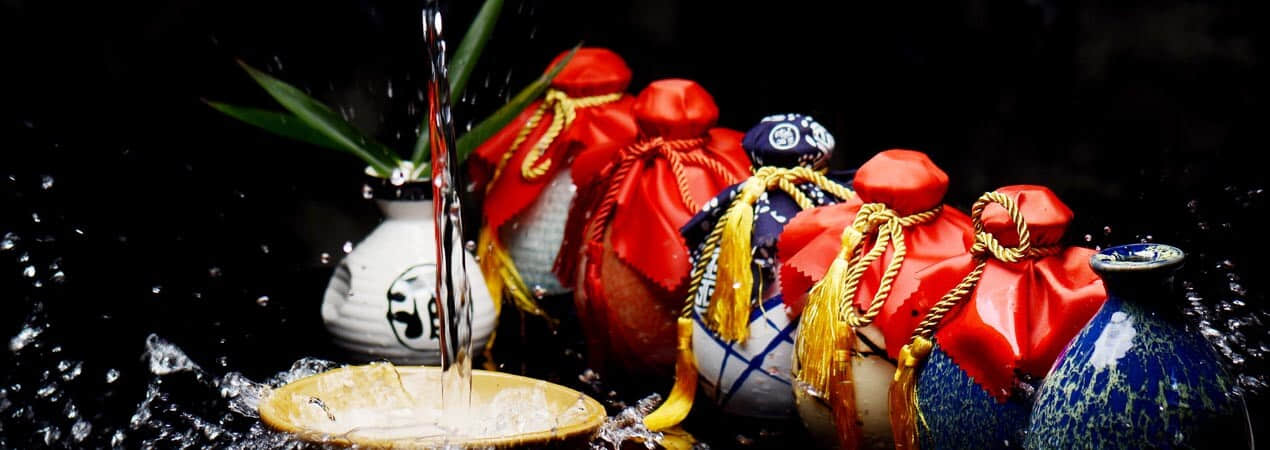
Have you heard about Baijiu (白酒 bái jiǔ pronounced as bye-joe)? You may have not heard about it if you have not traveled to China or visited one of the stores that sell it. Did you know it accounts for almost a third of global spirit sales and is the most consumed liquor by volume, by far?
Baijiu, is distilled from sorghum and other cereal crops and is served at every banquet and festive occasion in China. You can find it on the tables from wedding receptions to business banquets. Chinese people believe that "a banquet is not complete without baijiu", and it is considered impolite to drink baijiu without offering a toast.
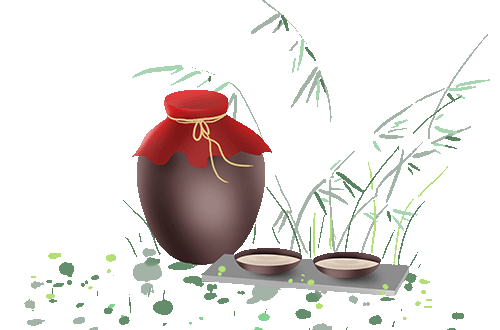
Contents
- What is Baijiu
- The Origins of Baijiu
- How is Baijiu Made: 5 Steps
- Baijiu Aroma Types
- Top 10 Baijiu Brands and Prices: Maotai, Wuliangye...
- Other Uses of Baijiu (Besides Drinking)
- Difference between Baijiu and Whiskey
- When is World Baijiu Day?
What is Baijiu?
Baijiu, literally means white liquor, is distilled from one or more of these raw materials in varying amounts: sorghum, wheat, rice, glutinous rice, and corn. It is as clear as mineral water.
Baijiu is typically between 40% to 60% alcohol by volume, with a strong aroma that is complex and aromatic. A single sip is often likened to swallowing a mouthful of flames. Hence its nickname "firewater". It's a drink not taken on its own, but often at meals. It's a family of drinks, with a variety of different brands, flavors, and scents.
The Origins of Baijiu
The exact origins of baijiu are unclear. But one thing is certain: The invention of alcohol predates recorded history in China. In 1983, archaeologists unearthed artifacts from the Jiahu site (circa 7000-5700BCE) in China's central Henan Province. Analysis of the pottery revealed traces of residue of alcohol made from grapes, honey, hawthorn fruit, and rice. It is one of the oldest known findings of alcohol distillation. In addition to yielding the world's oldest wine and some of the oldest rice and earliest playable musical instruments (bone flutes), it may have also yielded the earliest examples of Chinese writing.
In terms of technology, methods for distilling alcohol into spirits have existed as early as the Eastern Han dynasty (25-220 CE). The evidence is that we can still use the Eastern Han dynasty bronze to get baijiu at 20%-26% alcohol by volume. The bronze still is housed in the Shanghai Museum.
During the Tang Dynasty (618-907 CE), poets such as Li Bai mentioned a spirit called 'shaojiu' in their writings. There is a possibility that shaojiu's distillation techniques and ingredients were similar to baijiu, but that is unclear today.
A Song Dynasty (960-1279CE) text dated 982 CE describes a distillation method using wheat and barley that also exactly resembles the modern-day approach to making baijiu. Some scholars hold that foreign distillation techniques were introduced to China during the Yuan Dynasty (1271–1368CE). It wasn't until the Ming Dynasty (1368 – 1644CE) that shaojiu 'burnt wine' was refined as Baijiu and the liquor spread in popularity – initially with farmers and laborers and then to all corners of Chinese society.
As baijiu traveled throughout China it began to take on different characteristics that define the varying aromas. Almost every city and village that made baijiu began to form their unique characteristics, therefore in time it became more and more adept at developing the many varieties that baijiu inhabits to this day.
How is Baijiu Made?
Just like Chinese dishes, the flavor is different from different chefs. Every distillery produces its own, distinct form of baijiu. In many cases, the recipes for a particular baijiu are passed down from generation to generation. The production process is similar to all the baijiu brands. There are 5 main steps for the process:
Step one: Choose and prepare baijiu ingredients
The ingredients consisted of one or more of the following grains: sorghum, wheat, rice, glutinous rice, and corn. Different distilleries and brands of baijiu use different grains, depending on what is grown in their area. Wuliangye brand uses all of them but Maotai uses just sorghum. Good quality ingredients produce baijiu. High-end baijiu chooses their ingredients very carefully. Maotai only uses hongyingzi sorghum that only grows in the Maotai town area. Hongyingzi sorghum is a kind of organic glutinous red sorghum. All the ingredients are pulverized, boiled, and steamed.
Step two: Add Qu (distiller's yeast)
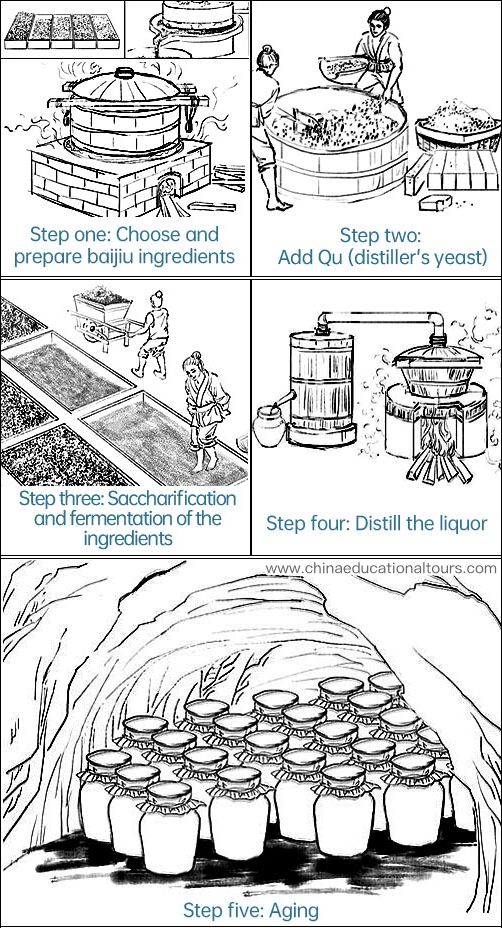
Qu, also known as jiuqu and pronounced as "chew", is referred to as the flesh of baijiu. The purpose of qu is essential for the saccharification of the baijiu. Without qu, there would be no form of Chinese liquor.
Qu is a distinct Chinese invention. The process is pulverizing the grains and occasionally complimented by popular herbs. The qu is then mixed with spring water and takes the shape of a solid ball (aka xiaoqu) or a brick (daqu). The qu is then stored away.
There are two kinds of qu; big qu (大曲 Da qu) and small qu (小曲 xiao qu). Sauce Aroma baijiu and Strong Aroma baijiu uses big qu. Rice Aroma baijiu and Light Aroma baijiu will instead use small qu.
Big Qu is made from grain. This is most often sorghum. Barley, peas and the husks of grain are also used. It depends on which province the qu is being prepared in, and which grains are available.
Small Qu is made from rice, as opposed to grain, giving baijiu a lighter taste. This rice is a long-grain, or glutinous, depending on the manufacturer's taste preference.
Step three: Saccharification and fermentation of the ingredients
The saccharification process is achieved by adding powdered qu to the core ingredients of the baijiu, along with water. Most distilleries prefer to use a natural water source for this process, such as from a stream or river. In the case of Maotai, they use water from Chishui River. If there is not a river or stream near a distillery, they would use water from a well.
The ingredients, qu and water will then be left enabling the microorganisms and bacteria to combine. This is how the starch found in the grains, or rice turns to sugar. This, in a nutshell, is saccharification – literally 'to make into sugar'.. Once this process is complete, fermentation of the baijiu can begin.
How and where these ingredients are left to ferment is what defines different brands, flavors, and aromas of baijiu. There is no one-size-fits-all policy. Sometimes, the drink is left to ferment in a mud pit under the ground, like the pit of Luzhoulaojiao. Other manufacturers will use a ceramic jar or pot. It's even possible to simply apply everything to a glass bottle, which is kept in a cool, dry place.
Ultimately, however, the result is the same. When the fermentation of the baijiu is complete, the ingredients make a thick, mushy soup. If the liquid of this mixture was strained, an alcoholic beverage would be ready to be bottled and sold. This would not be baijiu, however. It would be more like ancient Chinese wine. The ingredients and taste would be similar, but it would lack the famous strength and high alcohol content of baijiu. That requires the process of distillation.
Step four: Distill the liquor
To distill your baijiu pulp, you'll need a device called a still. This will pluck the spirits from the existing ingredients, boiling at a much lower temperature than water to maximize the alcohol content.
Chinese distilleries rarely use the modern apparatus that you'd find in a whiskey distillery for their baiji. Instead, they use large old-fashioned steamers that apply a delicate level of heat and turn the alcohol to vapor.
Once the steam heat has vaporized the alcohol, it's collected and placed in a different vessel. From here, it cools and becomes liquid. This is distilled alcohol, hence why the process is known as distillation. As it's essentially pure alcohol this gives baijiu the strong flavor.
Step five: Aging
Once the baijiu has successfully distilled, in theory, it's ready to be bottled and sold to paying customers. Low-cost baijiu, fresh from the production line, is available all over China and remains very popular. A more reputable brand, however, may be stored to age for as long as five years. The longer baijiu is stored to age, the more flavor the finished beverage will have. This is why aged baijiu, especially famous brands that have been stored for several years, are considered highly valuable collectors' items.
Unlike popular western spirits and wines, baijiu is not stored in oak casks. While baijiu is left to age, it is typically left in clay pots. These pots are often located in underground cellars, or within caverns found in cliff ranges. This allows the liquid to breathe, and interact with oxygen.
Baijiu Aroma Types
There are four main categories of baijiu: Strong Aroma, Sauce Aroma, Light Aroma, and Rice Aroma. Within these definitions, however, there are several smaller sub-categories. Which aroma of baijiu produced by a distillery largely depends on the ingredients used. Strong and Sauce Aroma Baijiu, for example, will be produced by distilleries with easy access to corn and grains. Sweeter, more palatable baijiu, such as Light or Rice Aroma, will be created by distilleries without easy access to fresh crops.
Geography also plays a part in which how baijiu is processed. Rice Aroma Baijiu, for example, is exclusively produced in the south of China. This means that other parts of the country struggle to obtain this type of baijiu. The opposite is true of Light Aroma Baijiu, which is native to the north of the country.
Strong Aroma Baijiu, meanwhile, is closely linked with the Sichuan province. This is due to baijiu pairing very favorably with the local cuisine, which is very heavily spiced. Sauce Aroma Baijiu is most commonly associated with Moutai, the nation's most reputable baijiu brand, which is produced in Guizhou Province of southwest China.
Strong Aroma Baijiu
Strong Aroma Baijiu is famed for its very potent taste. Not only does this spirit have a distinctive scent, but it also has a very particular taste and very complex spirit. The ingredients typically involve sorghum alongside at least one other grain. Anything unsuitable for use with the baijiu is recycled as food for livestock.
Closely associated with the regions of Sichuan, Jiangsu, Shandong and Anhui, Strong Aroma Baijiu blends fierce potency with a sweet, fruity taste. This makes complimentary when paired with spicy foods. This is a relief for many baijiu drinkers, as Strong Aroma Baijiu has a very high alcohol content.
Light Aroma Baijiu
Light Aroma Baijiu is created from sorghum and big qu, which is then fermented in glass jars. Barley and peas are the key ingredients of Light Aroma Baijiu. This gives the spirit a more floral and sweet taste. Light Aroma baijiu is very popular in northern China, especially in Beijing. The brand Erguotou, falls into this category.
Sauce Aroma Baijiu
Sauce Aroma Baijiu takes its name from the flavor. Most baijiu drinkers will associate with baijiu with the taste of soy sauce. This is not surprising to people that are familiar with Chinese condiments, as soy sauce is created using qu.
Sichuan and Guizhou are the territories most commonly linked with Sauce Aroma Baijiu. This aroma undergoes the most labor-intensive production process, undergoing multiple fermentations. It can take up to a year for this baijiu just to ferment. Once this is complete, the distillation process will then undergo up to eight different cycles. Herbs and beans are also included in the distillation of Sauce Aroma Baijiu, which creates a mellow taste sensation that lingers long on the tongue. The most famous Maotai falls into this category.
Rice Aroma Baijiu
Rice Aroma Baijiu is the lightest form of baijiu. As a result, Rice Aroma Baijiu is often compared to Chinese wine and the Japanese spirit Saké. This spirit is fast to produce, as it exclusively uses small qu. A typical Rice Aroma Baijiu will complete fermentation in around a week, and age for up to a year. Due to the lesser strength and flavor, this form of baijiu is usually priced at the lower end of the range.
A fine example of this type of baijiu is Guilin Sanhua, made using water sourced from the picturesque local Li River.
Top 10 Baijiu Brands and their Prices
Every region of China has its baijiu distillery. As a result, the residents of these territories have their preferences of baijiu. These may vary between different aromas.
What makes the best baijiu depends on the tastes of each individual. Some baijiu enthusiasts look for a brand that pairs well with a particular food. Others may prefer very strong baijiu, while others will prefer something lighter and more fragrant.
These ten popular brands of baijiu are considered to be among the best and ranked by brand awareness and overall popularity. The brands are not listed in any particular order.
No.1 Maotai (or Kweichow Moutai 贵州茅台)
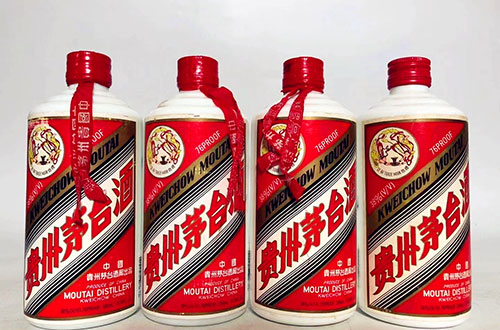
It is the most revered Chinese baijiu. It is served at all Chinese state banquets and often presented as a diplomatic gift. American President Richard Nixon and Chinese Premier Zhou Enlai toasted each other with Maotai at a banquet in the Great Hall of the People in Beijing, on February 1972. Henry Kissinger once told Deng Xiaoping, "I think if we drink enough Maotai we can solve anything."
NO.2 YangheDaqu (洋河大曲)
Produced in Yanghe Town, Jiangsu Province in eastern China, YangheDaqu has a history of more than 400 years. It was presented as a tribute to the royal court during the Qing Dynasty (1644-1911 CE).
It is a Strong Aroma Baijiu, with a sweeter taste than most competitors. This means that for a first time baijiu drinker will most likely enjoy the brand.
No.3 Wuliangye (五粮液)
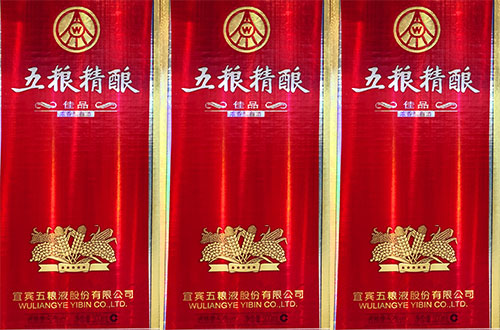
Wuliangye means "liquor brewed with 5 grains". It is made from a blend of five organic ingredients, sorghum, glutinous rice, rice, wheat, and corn delivering a unique aroma and taste. It was created during the Ming Dynasty (1368-1644) using Yibin’s local spring, the purest water sourced from the Sichuan province in southwestern China.
NO.4 The Shui Jing Fang (水井坊)
Located in Chengdu of the Sichuan province in southwestern China, is listed in the Guinness Book of Records as China's oldest distillery. It is claimed that this distillery dates back to 1408. Shui Jing Fang is aged for a minimum of five years before being blended with spirits (typically 40 years old) and activated charcoal and released to retail. The major shareholder of this brand is Diageo, which also owns other reputable brands as Smirnoff and Guinness. This baijiu earned two Gold medals at the 2015 World Spirits Competition.
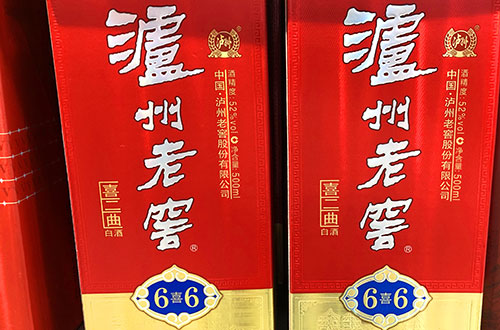
No.5 Lu Zhou Lao Jiao (泸州老窖)
Established in 1573, one of the oldest distilleries in China, it is famous for being produced in an environment with a unique clay composition that gives the spirit its famous aroma and taste. Its production technique was added to China's "List of National Intangible Cultural Heritage" in 2006.
No.6 Lang Jiu (郎酒)
Langjiu is named after the town of its origin, Erlang (near the Chishui River, about 40km from Maotai), in Sichuan Province. Langjiu is made from cool, fresh spring water from the Dragon Cave Mountain. It is stored in the natural Tianbao Cave and Dibao Cave before being sold. Its history can be traced back to the Han Dynasty during Emperor Wu (135 BCE). The modern distillery was set up in 1898.
NO.7 Fen Jiu (汾酒)
Is produced in Xing Hua Cun (Apricot Flower Village), Fenyang, Shanxi Province in northern China. It is also known as Xing Hua Cun Jiu. Xing Hua Cun has a long history of baijiu production; as early as the 6thcentury and was listed as a tribute to the royal family. The place is featured in the poem "Qing Ming" from the famous poet Du Mu (803-852 CE) of the Tang Dynasty. The last two lines read "Where can I find a wine shop to drink? The shepherd boy points to Xing Hua Cun faraway".
NO.8 Jian Nan Chun (剑南春)
Its history dates back to the reign of Emperor Dezong during the later Tang Dynasty period ( 742 - -805CE). Jian Nan Chun was an imperial liquor of that dynasty, is currently the only well-known Chinese liquor brand that can boast of such a historical lineage. Its unique brewing process has remained unchanged for more than a millennium, combined with the brand's fermentation process in age-old cellars, that creates a taste profile that is described as having a "strong, rich fragrance, a pure and sweet flavor, and a refreshing yet lingering taste". Jian Nan Chun was loved by the "Immortal Poet" Li Bai (701- 762CE), according to legend, and Li Bai pawned his minx vest to pay for one more drink.
NO.9 Xi Feng Jiu (西凤酒)
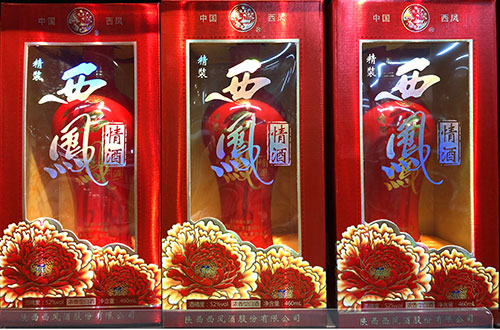
Produced in Fengxiang County, Shanxi Province in northwestern China. It is one of the most famous and time-honored liquors in China. Xi Feng Jiu boasts a long history that dates back to the Tang Dynasty (618-907 CE). It has a sweet, bitter, spicy, and fragrant flavor which is a unique flavor category—Feng Xiang—a style that combines aspects of strong and light-aroma baijiu.
NO.10 GujingGongjiu (古井贡酒)
Produced in Bozhou, Anhui Province in eastern China. The Gong, in the name Gu Jing Gong, means tribute offered to the royal family. Gujing, means 'old well'. The water used in the artisanal brewing procedure is sourced from a well that is nearly 1000-year old. First brewed in Bozhou in Anhui Province in 196 A.D. it exudes essences of the grains from which it is fermented, characterized by a lingering pleasing aftertaste.
Below we listed prices for one flagship product for each of the top 10 brands (the prices are for reference only).
| Brand name | Product name | Year of produce | Volume (ml) | Alcohol by volume | Price |
|---|---|---|---|---|---|
| Maotai | MoutaiFeitian (飞天茅台) | 2018 | 500 | 53% | 2758yuan (390USD) |
| Wuliangy | Wuliangye1618 (五粮液1618) | 2018 | 500 | 52% | 1119yuan (158USD) |
| Luzhou Laojiao | Guojiao 1573 (国窖1573) | 2018 | 500 | 52% | 956yuan (135USD) |
| YangheDaqu | MengzhilanM9 (梦之蓝M9) | 2018 | 500 | 52% | 2029 yuan (287USD) |
| Shuijinfang | DiancangDashiban (典藏大师版) | 2018 | 500 | 50% | 1035yuan (146USD) |
| Lang Jiu | Qinghualang (青花郎) | 2016 | 500 | 53% | 1281yuan (181USD) |
| Jian Nan Chun | Shuijingjian (水晶剑) | 2018 | 500 | 52% | 418yuan (59USD) |
| Fen Jiu | Qinghua30 (青花30) | 2018 | 500 | 53% | 799yuan (113USD) |
| Xi Feng | Guodianfengxiang (国典凤香) | 2018 | 500 | 55% | 649yuan (92 USD) |
| Gu Jin Gong Jiu | Nianfenyuanjiang Xianggu 20 (年份原浆 香古20) | 2018 | 500 | 52% | 788yuan (118USD) |
Other Uses of Baijiu (Besides Drinking)
Baijiu is generally consumed as a tipple, but it can also be used in cooking. It can reduce the smell of fish or mutton. If you add it into the batter when you fry something, it dissolves some of the gluten proteins in the flour, stopping the crust from becoming tough.
You can also apply it to a minor wound as it is an antibiotic.
The most popular use for baijiu is preparing paojiu (泡酒), or infused liquor. Chinese have been infusing baijius with Chinese medicine for centuries; ancient Chinese people even used baijiu to wash down certain Chinese medicines.
Chinese people drink different paojiu during different festivals: we drink Tusujiu during the Chinese New Year period, the ingredients of it includes rhubarb, atractylodes rhizome, cinnamon bark, platycodon root, zanthoxylum fruit, processed aconite root, and smilax rhizome.
On Dragon Boat Festival, we drink Xionghuangjiu or realgar liquor. It keeps away bugs and acts as a detox for the five poisonous creatures (poisonous snake, scorpion, centipede, gecko, and toad). It can also be used to treat sores and bug bites. The only catch is that realgar wine itself is toxic, so you can't drink too much of it.
On Middle Autumn Day, Guihuajiu or Osmanthus wine is consumed and one of the most notable Chinese floral wines, osmanthus wine, tastes mellow and sweet and is enjoyed by many.
On Chongyang Day or Double Ninth Day (the 9th day of the 9th lunar month), a festival to show respect to the elders, Chrysanthemum Wine is drunk. It is believed that by drinking chrysanthemum wine on the Double Ninth is said to promote good health and prolong life.
Depending on what you leave soaking in it (medicinal herbs, or goji berries, or venomous vermin like snakes and scorpions), paojiu is said to help with any number of ailments, as the alcohol unlocks mysterious medicinal qualities from the submerged ingredients. Don't be surprised if you found a jar of paojiu with a snake in it! Besides home-made paojiu, there are some famous brands that you can buy from supermarkets in China.
JingJiu (劲酒)
Main ingredients: baijiu, water, yam, angelica, goji berry, astragalus root, cinnamon, clove. Function:Relieve fatigue and enhance immunity.
ZhuyeqingJiu (竹叶青)
Literally "bamboo leaf green liquor" is Fen Jiu brewed with a dozen selected Chinese herbal medicines like bamboo leaves and fructusamomi. The main health benefit is to enhance immune function.
YedaoLuguiJiu (椰岛鹿龟酒)
Main ingredients: Baijiu, trepang, goji berry, cinnamon, clove, mulberry, longan, jasmine, and fructusamomi. The main health benefit is to relieve fatigue and eases rheumatic arthritis pain.
Difference between Baijiu and Whisky (whiskey)
Both baijiu and whisky are made from fermented and distilled grains, but they use different production techniques. For baijiu, we add qu during the fermentation but for whisky, they add yeast.
| / | Baijiu | Whisky |
|---|---|---|
| Ingredients | Mostly from Sorghum, also wheat, rice or corn | Malted barley, corn, rye or other grains |
| Color | clear | yellow |
| Alcohol level | 40%-60% | 43% |
| Flavor | Rotten, sweet fruit flavor. Some types have an aroma similar to soy sauce | sweet, creamy, peppery, malty and so on |
| Aging | Ceramic or earthenware jars | Oak casks |
When is World Baijiu Day?
Do you know there is World Baijiu Day that is dedicated to Chinese Baijiu? Surprisingly most Chinese people have never heard about it. It was established by a Canadian living in Beijing. It is held on August 9th (because 8/9, or "ba jiu" in Chinese, sounds almost like baijiu) since 2014. The celebration of the world's most-consumed spirit (representing one-third of global spirit sales, according to WBD organizers) is aimed at helping people beyond its home market get familiar with the fiery Chinese grain alcohol.

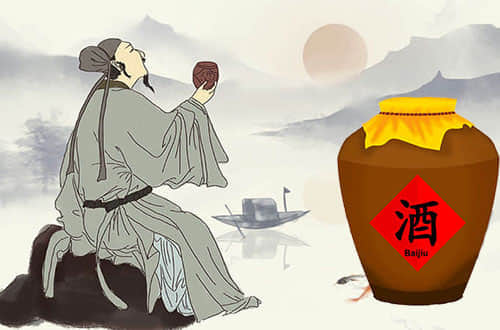 Baijiu in Ancient China
Baijiu in Ancient China 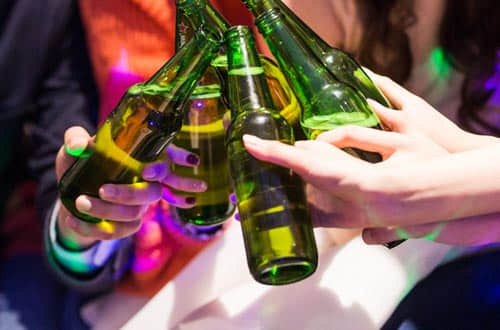 Baijiu Drinking Etiquette
Baijiu Drinking Etiquette 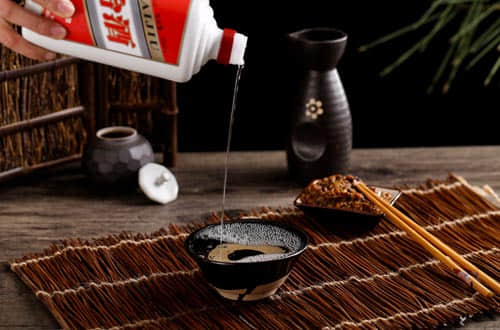 Baijiu Museums and Factory
Baijiu Museums and Factory 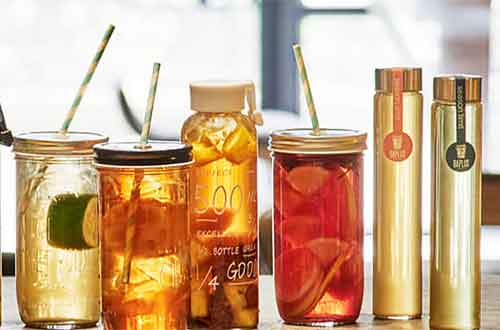 Chinese Beverages
Chinese Beverages 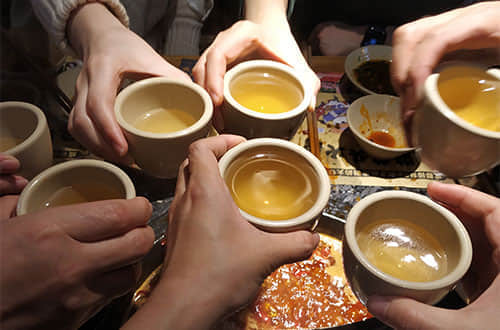 Ganbei (Bottoms up) - Chinese Drinking Culture
Ganbei (Bottoms up) - Chinese Drinking Culture 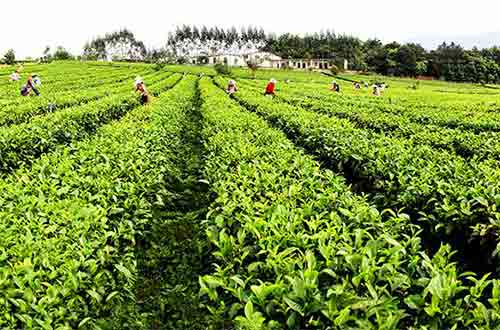 Chinese Tea
Chinese Tea 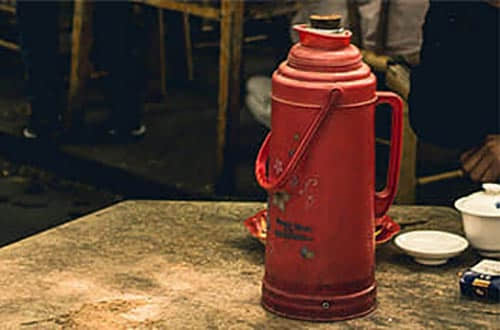 Hot Water in China
Hot Water in China  Drinking Water in China
Drinking Water in China